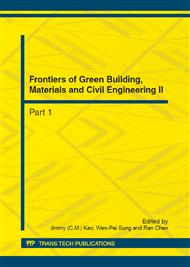p.157
p.161
p.165
p.169
p.176
p.180
p.184
p.188
p.193
Study of a Constructed Wetland-Pond System for Treatment from Campus Buildings
Abstract:
A constructed wetland-pond system consisting of a subsurface-flow (SSF) wetland, and a scenic pond in series was used for reclamation of septic tank effluent from a campus building. The results show that SSF wetlands effectively removed major pollutants under a hydraulic loading rate between 3.6 and 7.1 cm/d, with average efficiencies ranging from 85% to 86% for TSS, and 71% to 84% for BOD5. There were a variety of ornamental plants and aquatic animals established in the scenic pond with good water quality, thus enhancing landscape and ecology amenity in campuses.
Info:
Periodical:
Pages:
176-179
Citation:
Online since:
August 2012
Authors:
Price:
Сopyright:
© 2012 Trans Tech Publications Ltd. All Rights Reserved
Share:
Citation:


